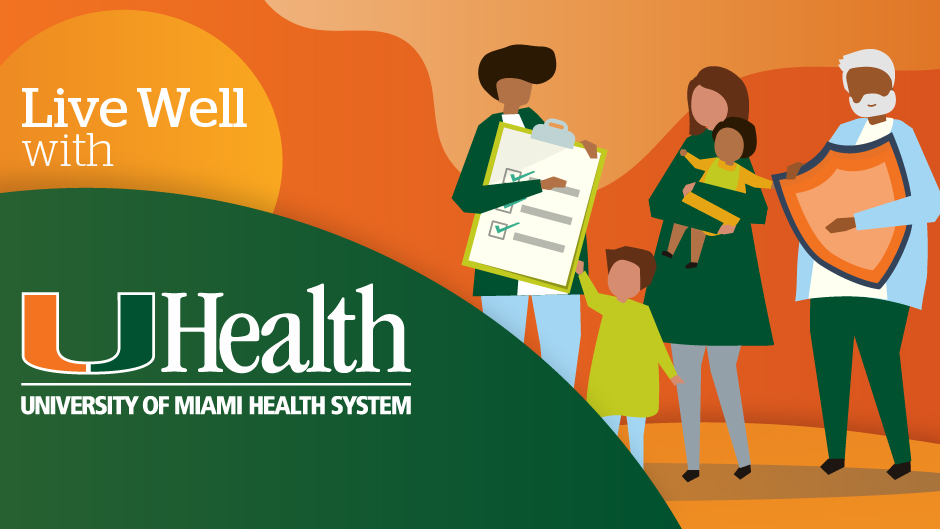For many individuals and families, summer often means spending copious amounts of time outdoors, traveling, and enjoying time with family and friends. Summer also coincides with the start of hurricane season, which runs from June 1 through November 30. It is essential to plan ahead and prepare in advance of any storm, including preparing a disaster kit with enough supplies for at least a week. UHealth public health experts explore a list of recommendations, which includes getting young children involved in the prep work.
Teach children to safely navigate their surroundings.
Drowning is the most common cause of injury or death among children, particularly between ages 1 and 4, and most instances occur in homes. By changing behaviors and installing safety features at home, caregivers can help prevent water-related injuries. Children as young as 12 months old can participate in swimming lessons, depending on the child’s comfort level and abilities. Learn more ways to keep children safe around water.
Playground-related injuries—about half of which are serious ones like severe fractures, concussions, traumatic brain injuries, and dislocations—are another concern faced by caregivers. According to the CDC, these injuries—and sometimes death—are more likely to happen on home playgrounds. Avoid a trip to the emergency room by making sure your child is not wearing any necklaces, drawstrings, or other loose objects or clothing that could get caught while playing in the park, including helmets. Choose age-appropriate equipment that is well-maintained and supervise your child. Find more tips on playground and park safety.
Children are naturally curious; they explore their surroundings in new ways—from rattling, throwing, and chewing on objects as infants and toddlers to picking up hobbies and sports and making new friends as they get older. Your child’s safety is paramount, which includes the storage and safekeeping of household objects that can pose a potential threat to curious children. As caregivers, you are responsible for controlling access to cleaning supplies and medicine cabinets; storing alcohol in an inaccessible area; and keeping firearms unloaded, locked, and safely stored out of reach. But, outside the home, it becomes even more challenging to control your child’s environment. UHealth public health experts shared suggestions about how to discuss firearms with friends and family members who are in control of places where your child may spend time.
From the widespread use of pesticides and fire retardant materials in our homes to wooden toys, which can be treated with harmful chemicals, it’s almost impossible to know your child’s exposure level to toxic and harmful chemicals commonly found around us, according to Dr. Lisa Gwynn, a pediatrician with the University of Miami Health System. Without proven scientific data, Dr. Gwynn explained that it’s difficult to pinpoint the risk and long-term effects. In her practice, she encourages parents to follow the age recommendations and any other safety warnings on the packaging. Discover more recommendations for protecting children’s physical safety.
Learn to spot a health concern.
Fun in the sun—and water—can often lead to issues like water-clogged ears and earaches, which are painful and common, especially among children. Dr. Leonardo Torres, a pediatric ear, nose, and throat specialist with the University of Miami Health System, encourages caregivers to recognize the signs of these common health issues and take care of them before they become bigger problems. Learn what to look for and when to seek medical attention.
For the first time since 2007, health care experts have updated national guidelines for diagnosing and treating asthma. The lung disorder—which can present at any age—affects patients differently depending on the person. With new research in certain areas, including allergy triggers, physicians—like Dr. Monica Raquel Cardenas, a pediatric pulmonologist with the University of Miami Health System—now have data to provide individualized treatment for patients with allergic asthma. Explore asthma symptom triggers.
Surprisingly, children as young as 2 years old can suffer from migraine headaches, although the vast majority of pediatric headaches are benign. While migraines tend to be more common among children and adolescents who have close family members who suffer from migraines, pediatricians noticed an increase in reported migraines during the height of the COVID-19 pandemic. Dr. Paige Kalika, a pediatric neurologist with the University of Miami Health System, was among the physicians who noticed an increase and worsening in pediatric migraine complaints. According to Dr. Kalika, migraines tend to be triggered by stress, including physical stress—like poor quality and insufficient sleep, unhealthy diet, and dehydration—and emotional or mental stress caused by social, academic, and family challenges. Learn more about migraines from Dr. Kalika, including symptoms and treatment options.
Access the medical care you need at a UHealth facility or via telehealth by scheduling an appointment. Find additional information about scheduling or call 305-243-4000.
Live Well with UHealth is a series that highlights curated content from articles previously published on UMiami Health News, a website that shares health tips and insights into research discoveries that change lives, brought to you by the experts at the University of Miami Health System. This story highlights the following articles.
- Hurricane prep 101: Tips for the whole family by Noah Sanders, Dr. Julie Belkowitz, and Dr. Oneith Cadiz, June 16, 2021
- Water safety: A parent’s guide by Anika Jain, Dr. Oneith Cadiz, and Dr. Julia Belkowitz, May 10, 2021
- Pools, parks, and a visit to the emergency department? by Emily Ramos, Dr. Julie Belkowitz, and Dr. Oneith Cadiz, April 15, 2021
- One question every parent should ask by Kathleen Kelly, Dr. Julie Belkowitz, and Dr. Oneith Cadiz, June 16, 2021
- Is this toy safe? by Dana Kantrowitz, June 16, 2021
- Is it swimmer’s ear or an ear infection? by Dana Kantrowitz, updated in April 2021
- What triggers asthma symptoms? by Ana Veciana-Suarez, May 5, 2021
- When children get migraines by Dana Kantrowitz, June 17, 2021

